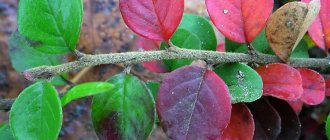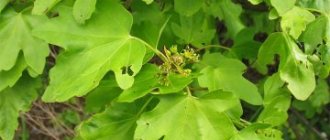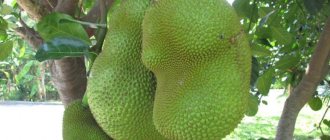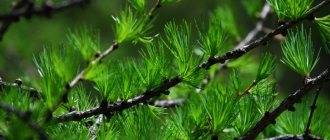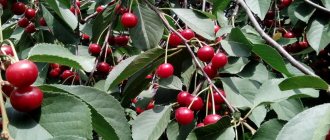Among the decorative deciduous shrubs in the landscape design of parks, gardens, dachas and cottages, the brilliant cotoneaster is very popular. It is unpretentious in care, but it looks beautiful from early spring to late autumn, decorating the territory with its flowering, foliage and fruits.
Cotoneaster brilliant - description
The most common plant of the Cotoneaster genus of the Rosaceae family is considered to be the brilliant cotoneaster (lat. cotoneaster lucidus). This deciduous shrub:
- It grows in the wild in China and the southern regions of Siberia. Prefers rocky slopes, pebble river banks, thickets of other shrubs and larch-mixed forests.
- Cultivated varieties are popular in gardens and parks throughout Europe and in the southern taiga zone.
- This cotoneaster is unpretentious in care and has a decorative appearance, tolerates pruning favorably, which is why it is often planted to create hedges and borders.
- In addition, the growth of the plant is slow - no more than 30 cm per year. The bush reaches its usual height only by the 10-11th year of life.
What does brilliant cotoneaster look like?
In a summer cottage, it is not difficult to recognize the brilliant cotoneaster:
- This is an upright growing deciduous shrub with densely pubescent young shoots of the current year. The height of the brilliant cotoneaster is about 2-3 m, and the diameter of the crown exceeds these figures by about 1.5 times.
- The leaf blade is pointed, ovoid or elliptical, 1.5 to 5 cm long and up to 3.5 cm wide. Smooth, dark green above, yellowish pubescent below. In autumn the color changes to purple, orange or red-brown.
- In May-June, loose corymbose inflorescences appear on the bush. Small pinkish flowers are located on the bush in such quantity that they almost completely cover all the leaf plates, attracting a large number of pollinating insects. Many people compare the bush during flowering to a lush pink cloud.
- For the first time, the brilliant cotoneaster bears fruit in the fourth year of life. They appear on the bush in late September - early October. They differ in spherical shape and diameter from 7 to 9 mm. Black and shiny, and the flesh is brownish-red. They stay on the bush until the first frost.
Cotoneaster brilliant - poisonous or not?
The black berries of the bush repel many novice gardeners with their appearance, who consider them poisonous. However, in the description of the cotoneaster shrub it is said that:
- The fruits of the plant are not poisonous, but have an unremarkable taste and aroma, which is why they are not used as food by people, animals, and birds.
- The lack of a pronounced taste and aroma allows them to be added only to table wines, liqueurs or some soft drinks to make them decorative.
- In folk medicine, cotoneaster berries are used to brew a decoction that helps treat ailments of the kidneys and excretory system.
Useful properties of cotoneaster
Cotoneaster berries are very rarely eaten. At the same time, it is valued by traditional medicine.
The following diseases and symptoms are treated with cotoneaster-based decoctions:
- jaundice;
- gastritis;
- nervous system disorders;
- fever;
- swelling;
- depression;
- hepatitis;
- scabies and eczema.
Berries are a natural antiseptic. Due to this property, they are widely used in folk medicine.
To treat gastritis, a tincture of leaves and branches of the bush is used. For 200 ml of water you will need 15 g of greens.
Cooking method:
- Branches and leaves are crushed.
- The mixture is poured with boiling water in an enamel saucepan and covered with a lid.
- The composition is infused for a couple of hours.
- Strain everything through cheesecloth folded 4 times.
Aluminum cookware should not be used to prepare the product, as oxidation processes occur quickly in it. Cotoneaster also treats flatulence.
To do this, prepare a decoction according to the following recipe:
- The berries are placed in a saucepan.
- Pour boiling water over the mixture and place on low heat.
- 10 min. the composition is heated, then cooled.
- Filter everything through gauze.
Take the resulting decoction 4 times a day, 100 ml. And you can store it in the refrigerator for no more than 5 days. Then the healing properties will be lost.
Cotoneaster brilliant - growing conditions
The bush has gained great popularity in landscape design not only for its decorative effect, but also for its absolute unpretentiousness when growing:
- The attitude of the brilliant cotoneaster to light is very democratic. It grows well in sunny areas and can withstand partial shade without losing its decorative properties. In deep shade, flowering and fruiting may decrease, the branches stretch unevenly towards sunlight.
- The culture is considered frost-resistant, because in most of the European territory it tolerates winters well even without special shelter.
- Cotoneaster is drought-resistant. Due to excess moisture in the soil (if groundwater is close or swampy), the rhizome may rot and the plant will completely die.
- Almost any soil is suitable. Cotoneaster will grow even on rocky, depleted soils. When planted in fertile soil, the shrub will grow, bloom and bear fruit better.
Should you be concerned about pests and diseases?
Cotoneaster brilliant can be affected by insect pests or diseases:
- Aphid. This is an insect that sucks sap from the stems and leaves of a plant. Unsightly marks remain on the green parts of the bush. You can remove aphids using a hose filled with water. High pressure will wash away insects from shoots and leaves.
- The scale insect can take a liking to the leaves and bushes of cotoneaster. This insect can even destroy the entire bush. Therefore, when it is detected, it is recommended to treat the plantings with an insecticide.
- An infectious disease called “bacterial burn.” It can not only destroy individual leaves and shoots, but in the absence of adequate action on the part of the gardener, kill the entire plant. In spring, when doing sanitary pruning, you should pay attention to cotoneaster branches. Be sure to remove those with visible ulcers. After just a few days, they may begin to secrete a light substance. If such branches are left on the bush, they will turn black in the fall, and the disease will spread to healthy shoots. Branches affected by the disease must be removed and burned. In advanced cases, it may be necessary to remove the entire plant.
- Powdery mildew. This is a fungus that is not very dangerous, but can lead to a deterioration in the decorative properties of the plant. Externally, powdery mildew resembles a powder that is scattered on the leaves and shoots of cotoneaster. Infection occurs due to increased humidity and cold. You can prevent the appearance of fungus by planting cotoneaster in a sunny place in holes containing drainage. Also important in prevention is the location of shrubs at a sufficient distance from each other. This allows all parts of the cotoneaster to receive the necessary light and ensures proper air circulation.
How to plant brilliant cotoneaster?
Proper planting of cotoneaster in the area is carried out according to the following algorithm:
- The optimal time for planting is mid-spring after the soil has thawed or early autumn for most temperate regions. If the plant was purchased with a closed root system (in a pot), then it can be planted in the ground even in summer without disturbing the earthen coma.
- As mentioned above, any soil will do. However, if the soil on the site is too heavy, it is better to dilute it with a third of river sand when digging.
- Planting holes, especially when creating hedges, are dug based on how quickly the brilliant cotoneaster grows. Due to the slow annual growth of about 30 cm, young seedlings can be placed at a distance of 50 cm to 1.5 m from each other in a checkerboard pattern.
- A drainage layer of expanded clay about 10-20 cm is laid on the bottom.
- A small layer of earth is poured on top, on which the root system of the plant is carefully placed. If the bush was sold in a pot, then there is no need to clear the roots from the soil.
- The remaining space of the planting pit is sprinkled with earth, which is lightly compacted. Each bush is watered with a bucket of warm, settled water.
- The space around the seedlings is mulched with dry grass, straw or peat.
Landing Features
The brilliant cotoneaster, the description and photo of which can be seen above, is easy to plant. However, some rules must be followed. The choice of landing site is not important. Since the main purpose of cotoneaster is to decorate the site, the location is chosen in accordance with the design decision.
Features of planting cotoneaster brilliant.
The shrub is not picky about light and soil moisture. The only thing worth taking care of is protection from the wind. It is better to prepare the soil for planting. This will help the young plant quickly get stronger and accelerate its growth.
Soil composition for cotoneaster:
- 2/5 turf;
- 1/5 peat;
- 2/5 sand.
It is a good idea to supplement the mixture with lime in a ratio of 300 g per 1 m² of planting.
Disembarkation scheme:
- pits are made about 50 cm deep and wide;
- drainage is poured to the bottom;
- seedlings are placed in accordance with the purpose of planting, for example, for a hedge you need to form 2 rows of them.
At first, the seedlings are well watered.
Cotoneaster brilliant - care
In the garden, brilliant cotoneaster requires minimal care, and even a novice gardener can grow it. Everything a culture needs:
- Watering. Only seedlings of the first year of planting need to be watered regularly. The procedure is carried out from May to October 2 times a week in the absence of rain and hot weather. Mature shrubs have enough ground moisture. They can be watered once every 2-4 weeks in dry weather. Approximately once a month, sprinkle the shrubs to refresh the foliage.
- Loosening the soil and removing weeds after watering. In this case, it is also recommended to mulch the tree trunk circle with a layer of peat or sawdust up to 8 cm thick.
- Regular fertilizing to stimulate plant growth and flowering.
- Formative and sanitary pruning of crops.
- Shelter for the winter is required only for young seedlings up to 3-4 years of age. If the winter is expected to be harsh, then they are covered with hay, spruce branches or branches.
How to feed brilliant cotoneaster in spring?
Proper spring care for brilliant cotoneaster includes regular fertilization:
- After the soil thaws during spring digging, organic fertilizers are applied under the bushes. This could be humus, manure or chicken droppings. Slurry is diluted in water in a ratio of 1:6, and chicken manure is diluted in a ratio of 1:10. The resulting solution is evenly watered around the tree trunks at the rate of about 1/2 bucket per bush.
- Immediately before flowering, around mid-May, the plant requires potassium-phosphorus compounds. For example, superphosphate is used, strictly following the dosages from the manufacturer.
- In mid-summer, a third fertilizing of nitrogen-containing fertilizers, such as urea, is applied. This fertilizer will help the bush grow even more green mass.
Haircut of brilliant cotoneaster
To maintain the decorative appearance of the plant, the brilliant cotoneaster must be cut. At the same time, experienced gardeners remind:
- Sanitary pruning is carried out every spring. All dry, diseased and damaged branches are removed.
- For decorative purposes, the timing of when to prune the brilliant cotoneaster varies from early spring to mid-summer after flowering has ended.
- In this case, the bush is pinched for the first time when its height reaches 60 cm. The upper shoot is carefully cut off to stimulate branching.
- Each subsequent haircut is carried out 2-3 years after the previous one, and it is important to remove no more than a third of the green mass.
- The brilliant cotoneaster is well suited for a curly haircut. Complex shapes are created by gardeners using sharp pruning shears, garden shears or a special hedge trimmer and pre-prepared cardboard templates.
Methods for harvesting cotoneaster
The fruits of the common cotoneaster do not have a wonderful taste, but are very healthy, which is why they are used when preparing tinctures and wines.
After drying the fruits and making a powder out of them, you can add them to the flour from which gingerbread is baked. In addition, this powder is used in the manufacture of sweets and marshmallows. Dried cotoneaster berries are used for a variety of purposes.
Collection and preparation of cotoneaster fruits.
There are no contraindications or side effects that may occur when consuming cotoneaster; however, this plant has not yet been well studied by scientists, so adverse effects may occur in people who have an individual intolerance to its composition.
How to propagate brilliant cotoneaster?
In a home garden, propagation of brilliant cotoneaster is carried out using the following methods:
- Seed
. This method is the longest and most painstaking. Seeds are collected in October and subjected to stratification throughout the year in a cool place: a refrigerator or cellar. In the fall, before planting, the seeds are poured with warm water for a day, removing any that float. Sow directly into the ground, deepening it to about 4-5 cm. The first shoots will appear in the spring or a year later, and the germination rate will be about 50%. - By cuttings
. To do this, both young and lignified branches in the spring are cut into cuttings about 15 cm long with 3-4 buds. In this case, each cutting is kept in a growth stimulator (Kornevin) and planted in a container with nutritious soil, covered with film. Ventilate and moisten the soil daily with a spray bottle. Ready seedlings can be planted in the fall or next spring. - By layering
. Shrubs with low shoots can be propagated using layering. Selected branches are bent to the ground, fixed with staples, cuts are made in the bark and sprinkled with soil. Next spring, young shrubs can be transplanted to a permanent location.
Features of cultivation
The brilliant cotoneaster does not require care. This is evidenced by both the description of the plant and the stories of experienced gardeners. But in order for the cotoneaster to delight the owner with its chic appearance and photogenic appearance, you will have to learn several rules for growing it.
Top dressing
The growth rate of cotoneaster depends on the regularity of fertilization. The scheme for introducing various fertilizers is given in the following table.
| Name | Breeding method | Time and method of feeding |
| Nitrogen-containing fertilizers | In accordance with the instructions for preparing the drug. | Necessary for the formation of a lush crown. Feeding is carried out throughout the summer season. |
| Organic | Manure is diluted in water in a ratio of 1 to 6 (for bird droppings 1 to 10). | The composition is watered on the bush in the spring after digging the soil. |
| Superphosphates | In accordance with the instructions for use. | Water the plant before the flowers appear and during flowering. |
| Complex fertilizers with urea and mineral fertilizers | 30g of powder per 10 liters of water. | Apply in spring during the period of bud formation on the plant. |
Trimming
Cotoneaster is used to create decorative fences and even plant figures. To obtain the proper shape, the bush is pruned. After the procedure, it grows well, but does not lose its shape.
To shape the bush you will need special trellis shears and tightly stretched twine. To create a clear figure, it is necessary to use a wooden form. You can make it yourself. But it all depends on the preferences of the owner of planting cotoneaster.
The wooden frame should be in the shape of a trapezoid, the upper part of which is approximately 15 cm narrower than the lower part. In this case, the frame is made with a small margin, designed for the growth of shoots. Before pruning begins, the frames are installed across the plantings. A rope is pulled between them, which will help adjust the upper part of the bush.
If you have to do a large amount of cotoneaster pruning, it is better to use a garden hedge trimmer.
Basic rules for pruning:
- use only sharp scissors and brush cutters;
- start pruning no earlier than when the plant reaches a height of 60 cm;
- cut your hair no more than 3 times a year.
Young plantings are pruned annually. Each subsequent year you need to harvest about 5 cm more than the previous year. The lower branches are shortened 15 cm less than the upper ones. They do this because the upper shoots grow faster and after a few weeks they shade the lower ones. This can lead to loss of bush shape.
Already from the second year, cotoneaster is trimmed regularly. This allows you to get a thick and beautiful crown. The branches are pinched, causing side shoots to grow. In early spring, sanitary pruning is carried out. It involves the removal of damaged, diseased and dry branches.
Cotoneaster grows slowly. Therefore, it does not need frequent pruning. Shrubs are usually trimmed in the spring. In some cases, the operation is repeated after flowering has ended.
How to propagate
Propagating cotoneaster is not an easy task. There are 2 main ways to do this: sow seeds and make layering. But other methods can also be used.
Seed method
The longest and most difficult method of propagating cotoneaster. But this is the only way to get many young plants at once.
There are 2 drawbacks that are very significant:
- even with ideally correct planting and care, no more than half of the seeds germinate;
- bushes of normal size, even remotely resembling adults, can only be obtained after several years.
A few secrets will help facilitate the propagation of cotoneaster by seed:
- Seed collection is carried out in mid-autumn. After this they are hardened. Store in a cool, dark place - in a cellar or refrigerator.
- Before sowing the seeds, they should be filled with warm water. In this way, you can calculate empty seeds; they will float up. The remaining ones are soaked for a day, thereby awakening them.
- Planting is carried out directly into the ground, deepening the seeds by 3-4 cm. The planting must be covered with mulch. The distance between rows should be at least 15 cm.
The first shoots will appear in the spring. And some seeds will only be able to germinate after a year. Cotoneaster is sown with a reserve, because not all seeds germinate. The ratio is approximately this: half will sprout in the spring, and next year another small part of the sprouts will appear.
Germination can be increased by hardening. Immediately after collection, the seeds are placed in a metal container and stored in the refrigerator or outdoors until spring. And only next autumn they are planted in the soil.
Even following all the rules when planting seeds does not guarantee good germination. Usually it is about 30% in the first year. Already by their first autumn, the sprouts reach a height of 30 cm. And after another year they can form beautiful decorative crowns. Cotoneaster blooms for the first time no earlier than 4 years after germination.
It is precisely because of the poor germination of seeds that cotoneaster is rarely found in nature. Features of germination can be taken into account when planning plantings. Some gardeners recommend planting seeds densely, and after 2 years, planting the grown bushes in the right places.
Vegetative propagation
The brilliant cotoneaster, the description and photo of which can be seen above, is most often propagated by the vegetative method. For this, cuttings are taken. The main rule is that they must be healthy and strong, at least 15 cm long. Each such cutting must contain two internodes.
It is best to start harvesting cuttings in mid-summer. Before planting, they are placed for a couple of hours in a root formation stimulator (Kornevin or any other similar drug). Then they prepare the soil for future bushes. It should consist of equal amounts of humus, turf and sand. Before directly planting the cuttings, the soil is well watered.
Plant parts are placed in the soil at an angle of 45°, each of them deepened by about 5 cm. Then the sprouts are covered with jars to create greenhouse conditions. It is important not to forget to ventilate the bushes and water them.
Propagation by cuttings can be either green or woody. The latter are cut before frost. After this, they are placed in sand and stored in a cool place. In spring, such cuttings are cut to a length of no more than 20 cm. It is worth paying attention to the fact that each of them has at least 3 buds. The resulting parts of the plant are rooted in the same way as described above.
Dividing the bush
An adult cotoneaster can be propagated by simply dividing the bush. This operation is carried out in early spring, even before sap flows through the shoots and branches. Use a sharp, clean tool to divide the bush.
The wounds must be sprinkled with ash, otherwise rot may damage the roots. When separating part of the bush, it is important to leave a lump of earth on the roots from the original place. This simple measure will allow the plant to take root faster.
By layering
Suitable for shrubs with low branches. To do this, the shoot, which is located no more than 10 cm above the ground, is bent even lower to the ground in spring and secured in this position with a metal bracket. Next, the shoot is sprinkled with soil.
After a while it will give new roots. To speed up this process, small cuts are made in the bark at the bottom of the branch. Usually the new plant is separated from the mother plant the following spring. This way it will survive the winter easier. But in case of urgent need, you can do this in the fall, when the roots become strong.
Do I need to cover it for the winter?
The brilliant cotoneaster, the description and photo of which can be found above, has good frost resistance. Despite this, in the northern regions it is better to cover it for the winter.
Dry leaves or peat are used for this. They try to press the branches to the ground. This will help preserve the buds in severe frosts. Covering material is poured onto the bushes. Its thickness should be at least 7 cm. After snow falls, you can also throw it at the bushes, forming peculiar snowdrifts.
How to transplant brilliant cotoneaster?
In some cases, the bush requires replanting or dividing the bush. Wherein:
- The best time for the procedure is considered to be early spring before self-propulsion begins, since the operation is relatively traumatic for the cotoneaster.
- Using a disinfected sharp instrument, the bush is divided into parts or dug out of the ground along with the soil. All cut areas are treated with garden pitch or crushed ash.
- It is better to leave the transplanted part of the plant with an earthen lump, which can be slightly moistened.
- A nuance of how to plant brilliant cotoneaster is considered to be more careful care of the plant in a new place during the first year. It requires regular watering, like young seedlings, and feeding.
Preparing the common cotoneaster for wintering
Hedges produced by common cotoneaster are not afraid of frost and prolonged hypothermia. Winters with little snow do not harm cotoneaster. Only in cases where a too severe winter is predicted, you need to know how to properly prepare the plant for it. The shrub is covered with dry leaves or peat. If you bend its branches to the ground, the flower buds will be protected from frost.
Caring for cotoneaster in winter.
Cotoneaster brilliant - diseases
Both deciduous and evergreen brilliant cotoneaster have stable immunity to disease. The only disease that can affect him is fusarium. This is a fungal infection that occurs when soil moisture is high. Manifested by yellowing and falling leaves. At the first signs of illness:
- The diseased bush is completely removed from the ground and disposed of far from healthy crops, for example, by burning.
- Healthy neighboring plants and the soil under the diseased bush are treated with a fungicide, for example, Bordeaux mixture or copper sulfate.
Plant characteristics
Cotoneaster lucidus or cotoneaster lucidus is a shrub that belongs to the Rosaceae family. Despite the similarity of names, it has nothing in common with dogwood. Although its fruits are edible, they are not eaten as they are tasteless. The value of the plant lies in its decorativeness and unpretentiousness.
This shrub is found wild in Siberia, Altai and the Far East, in China. It grows in rocky areas, so it is unpretentious, frost-resistant, and easily adapts to different conditions and any soil. These properties are now actively used for landscaping city parks and squares. The dense foliage of the bush is capable of absorbing dust from roads and purifying the air of gases.
When describing the brilliant cotoneaster, the following features can be noted:
- grows slowly, but reaches a height of 2-3 m;
- forms a very dense crown;
- stems are erect, strongly branched;
- lives up to 50 years;
- the leaves are small, oval, dark green in color, with a shiny glossy surface;
- in autumn the leaves turn purple;
- blooms in May - June, the flowers are small, white-pink, there are so many of them that they often cover all the foliage;
- the fruits are small berries that ripen in September, first bright red, then blue-black.
Cotoneaster is a beautiful, unpretentious plant that is actively used for landscaping.
Shiny cotoneaster - pests
Under unfavorable conditions, the cotoneaster bush can be affected by the following pests:
- aphids;
- moth;
- scale insect;
- spider mite.
If one of the insects is present, the bushes are immediately treated:
- Traditional methods
, if there are few pests. This can be an infusion of garlic or potato tops, a decoction of wormwood or yarrow.
Broad-spectrum insecticides
How to propagate
There are several ways to propagate cotoneaster. The first includes vegetative, which is performed using cuttings. This method requires the use of large and developed shoots. Poorly bending or soft ones will not work. You need to cut the cuttings into segments 10 centimeters long each. To speed up the process of root emergence, a growth stimulator is used, which is usually heteroauxin. One tablet is diluted in 1 liter of water. Coarse sand is used as soil, watered with water, then a layer of 3 centimeters is formed. The depth of planting cuttings is 5 centimeters. The root system will be formed by autumn, which already allows the plant to be planted in the garden. However, in order for them to survive their first winter well, they will need a shelter made of spruce branches. Reproduction is possible using winter cuttings. To do this, you will need to prepare shoots in December and store them in the basement, and when spring comes, cut cuttings 10 centimeters long so that there are 3-5 buds. If you prefer to sow seeds, then you need to take into account that usually more than half of them turn out to be of poor quality. To select those suitable for planting, you need to wash them from the pulp and soak them in water. Inferior ones will emerge who will not be able to settle down. On average, approximately 40% of the seeds remain, and all of them germinate, but you will have to wait at least a year to speed up germination; they use stratification. You need to mix the seeds with peat and sand, add water, mix the mixture and add it to the pot. The layer must be at least 30 centimeters. It is recommended to keep the temperature at 0 degrees. The stratification process should last about 2 months, but if you use Shiny or Pink cotoneaster seeds, the period is extended to 6 months, and for Multi-flowered - up to 1 year. Dummer's cotoneaster requires a different temperature regime: first, the soil mixture is kept for 3 months at a temperature of 20 degrees, after 9 months the temperature is reduced to 7 degrees. If you resort to treatment with sulfuric acid (no more than 20 minutes), you can shorten the stratification period by about a month, but this will have a detrimental effect on seed germination. If you prefer to use boxes for sowing, add fertile soil to them, which should consist of equal proportions of sand, peat and humus. It is recommended to add water to soak the seeds. The seeds themselves do not need to be buried in the ground - literally 5 millimeters of depth is enough. Sprinkle about 1 centimeter of sand on top. As soon as the seeds begin to sprout, be sure to provide them with water. But be careful, otherwise the water will wash away all the sprouts. If such a problem arises, simply deepen the seeds again.
Why does the brilliant cotoneaster dry out?
Some gardeners complain that the cotoneaster shrub is starting to dry out. There are several reasons for this:
- Fusarium infection, which was mentioned above. The leaves of the plant begin to fall off, and then the bush itself dies completely. Affected bushes cannot be saved.
- Lack of moisture in the soil during too hot and dry summers. In this case, the bushes need to be watered generously weekly with water (about 1 bucket for each bush).
- Leaf burns due to improper watering. The plant needs warm, settled moisture in the morning or evening. Cold water on the leaves at noon leads to their injury from the sun's rays.
How to deal with plant pests
To ensure that various pests do not annoy the common cotoneaster, you only need to carefully examine the young shoots, in which apple aphids may appear on the back sides of the leaves. As a result, the leaves wrinkle and the shoots begin to bend and dry out.
Pests and ways to protect cotoneaster from them.
Young shoots can also be affected by fusarium mites and scale insects. Pest control involves treating plants with various decoctions; artificial preparations can also be used. Adult plants are not afraid of any pests.
Common cotoneaster can be affected by flavonoids. Then healthy parts of the plant are treated with fungicides, and those affected by pests are cut off and burned.
Cotoneaster brilliant in landscape design
The cult is often used to decorate the territory:
- In single plantings or adjacent to other crops. At the same time, curly or topiary cutting of plants is very popular, creating a variety of shapes that organically fit into the style of the garden.
- Creation of hedges, decorative green borders, which are regularly trimmed. A hedge of brilliant cotoneaster can be of various sizes depending on the variety of shrub and the desires of the gardener.
Interesting Facts
Cotoneaster is a common plant, but no less interesting for that.
Interesting notes about him:
- The shrub is highly adaptable to a variety of growing conditions. That is why you can find the plant in many places on the planet. Even in Africa, cotoneaster grows.
- The lifespan of the plant is about 50 years. Having planted a hedge once, you can forget about the need to update it for many years.
- The simplest decoction for the treatment of gastritis and peptic ulcers can be prepared by pouring boiling water over the leaves of the bush. Take a sip of it several times a day.
- To diversify and enhance decorative qualities, several varieties of cotoneaster are used when planting hedges.
- Most often, cotoneaster is used as a decoration for a garden or plot. It makes an excellent hedge, which, due to its unpretentiousness and slow growth, does not create practically any problems for the gardener. It is easy to form and ensure that the shape is maintained.
On the Internet you can often find beautiful photos of hedges and various figures of vegetation. Very often the plant from which this beauty is formed is brilliant cotoneaster. Judging by the description, it is easy to care for and resistant to pests and diseases. Therefore, growing a shrub will not be difficult.
Preparation of planting material and propagation
Cotoneaster can be propagated by different methods:
- Seeds. If you do nothing, they will be sown from the bush on their own. However, in such a situation, the new plants will be quite weak, and they will bear fruit much worse. Therefore, it is better to purchase seeds in a specialized store. Such seed undergoes stratification from 3 to 12 months. Therefore, such planting material can be sown in the spring and be sure that it will quickly turn into full-fledged and mature plants.
- By layering. Cotoneaster very easily tolerates propagation using this method. To do this, you need to dig a small hole next to the main bush and bend one of its shoots to the ground. After this, it is secured with a pin and covered with earth. All that remains is to water it abundantly and wait enough time for the shoot to take root. When it has formed an independent root system, it can be cut off from the main bush and moved to any other place.
- Cuttings. If there is only one cotoneaster growing in the garden and you need to get as many seedlings as possible, then it is most convenient to cut cuttings. To do this, it is worth using those parts of the plant that have formed buds. You need to choose only healthy and fairly young shoots. The cutting procedure is performed in several stages. In July, you need to cut cuttings 10-12 cm long from the mother plant and remove all the leaves from them, leaving only the top two. After this, the cuttings should be placed in a pot with a small amount of soil, and sand should be poured into the bottom. After this, containers with future young plants are placed in the shade. If you don’t want to bring them into the house, then you can leave the cuttings outside, but at the same time make shelters for them from film so that the humidity inside is constantly maintained at a sufficiently high level.
Cotoneaster - propagation by cuttings and planting.
You also need to take into account that the choice of propagation type depends on the specific type of plant. For example, it is preferable to propagate evergreen varieties from semi-lignified shoots.
Advantages and disadvantages of the type
When growing brilliant cotoneaster, it is important to consider not only the advantages of growing this plant, but also take into account the existing disadvantages. The advantages of having brilliant cotoneaster on your site include the following:
- low maintenance and neat appearance;
- good resistance to both frost and dry periods;
- almost complete immunity to diseases;
- unpretentiousness in growing conditions (feels great in places of heavy air pollution with soot, dust, exhaust gases);
- undemanding to the composition of the soil and the level of illumination of the site.
All this allows you to plant brilliant cotoneaster seedlings in parks and even on city streets. At the same time, we must not forget about the disadvantages of choosing this particular plant for growing. These include:
- the need for regular pruning of cotoneaster;
- comparative difficulty of reproduction.
Of course, there are noticeably more advantages, so perhaps it’s worth thinking about buying seedlings.





